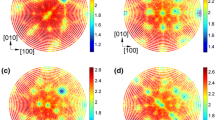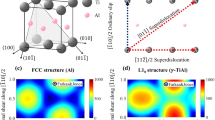Abstract
We review the application of Brandon’s criterion to identifying so-called “special” grain boundaries. The underlying principles of the Brandon criterion, and others that have followed it, are explained, and the choices of particular parameters within the criteria are considered in the light of experimental information in the literature. It is suggested that varying choices of the parameters may be appropriate for differing applications. An experimental study of the stability of CSL-related triple junctions is used to evaluate the applicability of Brandon-like criteria to these microstructural features.





Similar content being viewed by others
References
Brandon DG (1966) Acta Metall 14:1479
Warrington DH, Boon M (1975) Acta Metall 23:599
Watanabe T (1984) Res Mechanica 11:47
Pumphrey PH (1976) In: Smith DA, Chadwick GA (ed) Grain boundary structure and properties. Academic Press, London, p 139
Palumbo G, Aust KT, Lehockey EM, Erb U, Lin P (1998) Scr Mater 38:1685
Ishida Y, McLean M (1973) Philos Mag 27:1125
Gjostein NA, Rhines FN (1959) Acta Metall 7:319
Read WT, Shockley W (1950) Phys Rev 78:275
Turnbull D, Hoffman RE (1954) Acta Metall 2:419
Nakamichi I (1990) J Sci Hiroshima Univ A 54:49
Nakamichi I (1996) in Intergranular and interphase boundaries in materials. Pt 1, p 47
Dannenberg R, King AH (2000) J Appl Phys 88:2623
Dimos D, Chaudhari P, Mannhart J (1990) Phys. Rev B 41:4038
Wang JY, King AH, Zhu YM, Wang YL, Suenaga M (1998) Philos Mag A 78:1037
Schober T, Balluffi RW (1970) Philos Mag 21:109
Clark WAT, Smith DA (1978) Philos Mag A 38:367
Vitek V, Sutton AP, Smith DA, Pond RC (1979) Philos Mag A 39:213
Chen FS, King AH (1988) Acta Metall 36:2827
Sutton AP, Vitek V (1983) Philos Trans R Soc Lond Ser A 309:1
Balluffi RW, Schober T (1972) Scripta Metall 6:697
Pumphrey PH (1972) Scripta Metall 6:107
Bollmann W, Michaut B, Sainfort G (1972) Physica Status Solidi A 13:637
Ichinose H, Ishida Y (1981) Philos Mag A 43:1253
King AH, Smith DA (1980) Acta Crystallogr A 36:335
Bacmann JJ, Silvestre G, Petit M, Bollmann W (1981) Philos Mag A 43:189
Watanabe T (1983) Philos Mag A 47:141
Kim CS, Rollett AD, Rohrer GS (2006) Scr Mater 54:1005
Neumann FE (1885) Vorlesungen uber die Theorie der Elasticictat. Teubner, Leipzig
Kremer R, Narayanan R, Shekhar S, King AH (2005) J Mater Sci 40:2795
Acknowledgement
This work was supported by the US Department of Energy, under grant number DE-FG02-01ER45940.
Author information
Authors and Affiliations
Corresponding author
Rights and permissions
About this article
Cite this article
King, A.H., Shekhar, S. What does it mean to be special? The significance and application of the Brandon criterion. J Mater Sci 41, 7675–7682 (2006). https://doi.org/10.1007/s10853-006-0665-8
Received:
Accepted:
Published:
Issue Date:
DOI: https://doi.org/10.1007/s10853-006-0665-8




